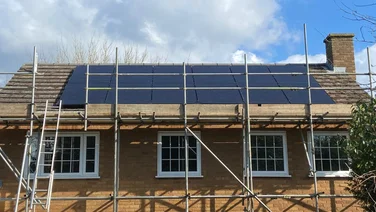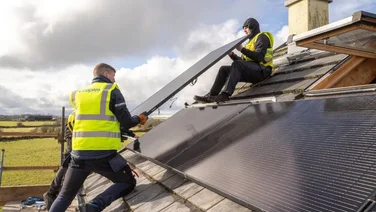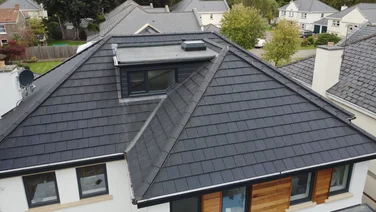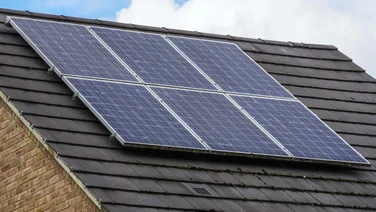✔ A solar scooter typically refers to an e-scooter with integrated solar panels
✔ It’s also possible to charge regular e-scooters using separate solar panels
✔ Solar scooters cost between £550 and £1,400, on average
Solar scooters are an exciting new technology that can help you save the planet when commuting to work or just out and about.
We’ll go over what solar scooters are, how they work, and how much they cost in this article. We’ll also assess their pros and cons, and whether they’re worth it.

What is a solar scooter?
A solar scooter usually refers to an electric scooter (e-scooter) with integrated solar panels that charge its battery.
Some people also interpret solar scooter to mean an e-scooter that can be charged with electricity generated from solar panels.
Either way, powering them with solar energy is intended to make e-scooters environmentally friendly.
To be clear, any e-scooter can technically be charged with solar-generated electricity. The issue is generating enough electricity to power the battery – small, portable solar panels often won’t do the trick.
Do solar scooters actually exist?
Yes, solar scooters already exist.
However, so far, only one company seems to be manufacturing e-scooters with integrated solar panels: Jiangsu Snail Zhixing Technology, also known as Agao.
The China-based company’s S80 Solar Scooter has been available for purchase since mid-2023, with shipments already sent to customers in Europe and the US.
On the other hand, when it comes to charging e-scooters using solar-generated electricity, AOVO Technology is leading the charge. The company has released several models of the AOVO Lirpe, an e-scooter that comes with a foldable solar panel.
The solar panel isn’t integrated into the scooter, but it can be connected to it to partially charge the scooter’s battery. The scooter can also simply be plugged into a regular chargepoint.
How does a solar scooter work?
Jiangsu Snail Zhixing Technology’s S80 is the only commercially available solar scooter with integrated solar panels, so we’ll use it as a basis for how potential future solar scooters could work.
The S80 solar scooter has two large solar panels, one at the front of the scooter, under the handlebars, and one at the base – the part you stand on.
These two solar panels can fully charge the scooter’s battery, although it takes a while to reach a full charge – usually seven to 14 hours. The scooter isn’t designed to be plugged into a chargepoint.
On the plus side, once fully charged, the solar scooter can go for 35 kilometres at a speed of 20 kilometres per hour, and the battery will charge while you ride, if you’re using it during the daytime.
If more manufacturers start making scooters with integrated solar panels, it’s possible they might also include a charging port. That way, users could benefit both from solar power and quick charge times in emergencies.
We’ll just have to wait and see what the future holds.

Pros and cons of solar scooters
- Zero-emission transport
- Runs on free solar electricity
- Can charge on the go
- Bulky design
- Long charge time
- Charging dependent on weather conditions
Advantages of solar scooters
One advantage of solar scooters is they’re a completely emission-free form of transportation.
Not all electricity comes from renewable sources – in the UK, only about 42% is from renewables, on average. With a solar scooter, you can be sure 100% of the electricity you use comes from renewable solar energy.
Another advantage of this is that solar energy is free. After purchasing your solar scooter, you won’t have to spend money on charging it – the electricity you use at home or at chargepoints isn’t free, after all. The scooter will charge itself when it’s out in the sun.
Lastly, solar scooters can charge on the go. This means you don’t always have to sit and wait to charge your scooter; it will top itself up as you ride.
Disadvantages of solar scooters
One key disadvantage of solar scooters is they’re bulky. Solar panels take up space, and in order to have integrated solar panels big enough to power the scooter, the vehicle has to be wider than a regular e-scooter.
The S80, for example, is around 14 centimetres at its widest point.
Additionally, charging a solar scooter might be free, but it takes time. According to Jiangsu Snail Zhixing Technology, its S80 scooter can take up to 14 hours to fully charge. For reference, regular e-scooters charge in around five hours.
Solar scooters can also only charge in certain weather conditions. They can’t charge at night, only during the day. This is a major inconvenience, since most people use their scooters in the daytime.
Plus, if it’s cloudy or raining, it’ll take the solar scooter even longer to charge, since it’ll be exposed to less direct sunlight.
Also, you’re not allowed to ride an e-scooter on the pavement in the UK. All vehicles, including bicycles, must be ridden or driven on the roads, and failing to do so can result in a fine.
How much do solar scooters cost?
Solar scooters cost between £550 and £1,400, on average.
This is based on the average cost of Jiangsu Snail Zhixing Technology’s S80 solar scooter with integrated solar panels, and AOVO Technology’s AOVO Lirpe scooter, which comes with a separate foldable solar panel.
This price range is relatively similar to regular e-scooters. The S80’s £1,400 price tag is on the expensive side, but it’s still a similar price to high end e-scooters.
Is it worth getting a solar scooter?
Whether it’s worth getting a solar scooter depends on your priorities.
If you’re looking for a quick, hassle-free way to get around, a solar scooter might not be worth it. This is mainly because it takes a long time to charge using solar panels alone, and charge times are dependent on weather conditions.
Plus, if you don’t have an outside area at home where you can leave a scooter to charge, it’s difficult to see how you could get any use out of it.
If you’re a green tech junky, and you want a sustainable way to get around that’s faster than walking, a solar scooter might be a good choice.
Just keep in mind that solar scooters are best suited to people who live in urban areas that get regular amounts of sun, and travel relatively short distances to work or school. Having an outside place to store the scooter so it can charge is also crucial.
Summary
It’s unclear whether solar scooters will become commonplace in the future.
In theory, having a scooter that can charge itself for free using the power of the sun is a great idea, but it’s not the most reliable or practical form of transportation.
A more convenient way to use solar energy to power your commute might be to use solar panels to charge your electric car.
For the more open-minded, there are other ways solar panels can be integrated into transport. We’ve seen that solar panels can be integrated into e-scooters, and some people are also putting solar panels on cars.






